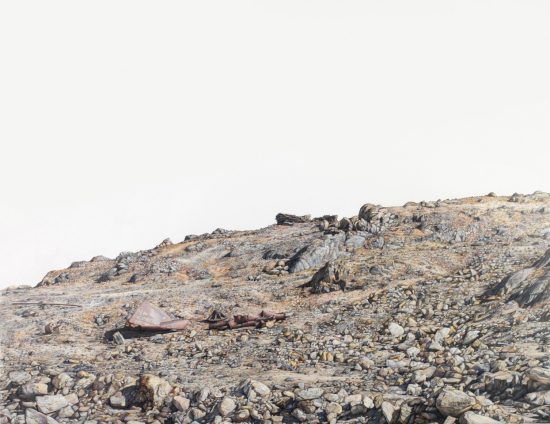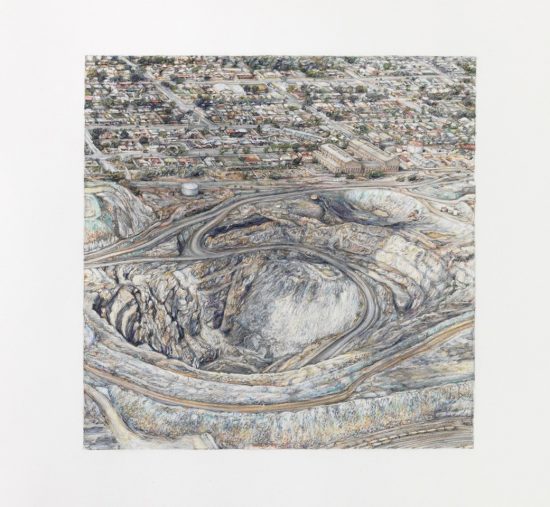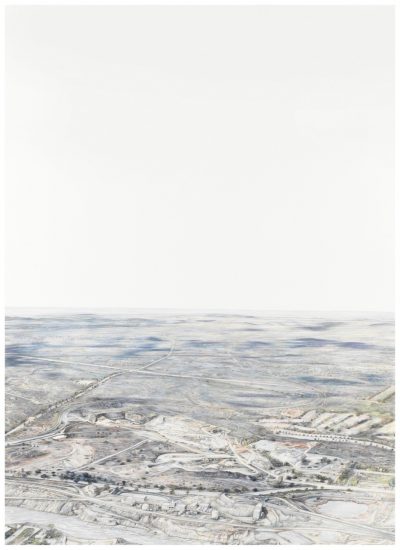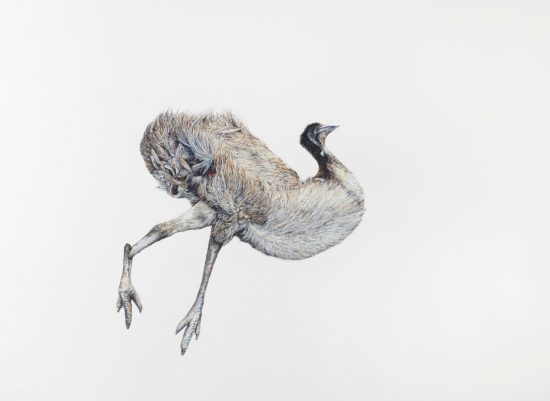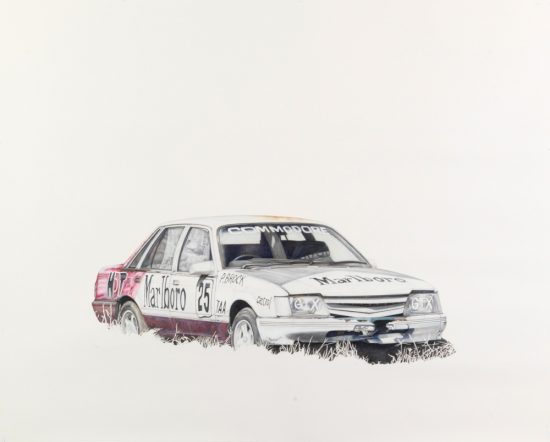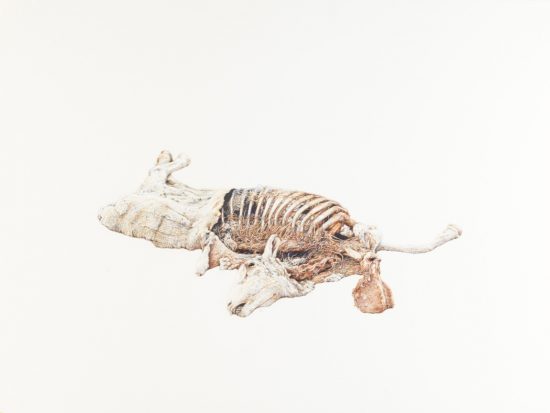Art Life editor Andrew Frost interviews Paul White on the process behind his new suite of drawings for Dirty Diesel & Dusty Deeds, the immensity of nature and Road Runner landscapes…
Paul White, ‘Fools gold (Like life on Mars)’ Pencil on paper, 100 x 130cm.
Andrew Frost: The new works in this show come from spending time in Broken Hill in far western NSW and Mildura in rural Victoria. You’d previously spent time in the deserts of North West America, so how did you end up coming back to the Australian landscape, and what’s the connection between these works and the older drawings?
Paul White: I had explored much of the deserts of California, Arizona and Utah and became interested in them as locations outside of the metropolis. I was interested in the vast emptiness, the inhospitable and the monumental, in how the notion of time can be clearly seen through exposure and erosion of the land. Each work or series of works leads into the next and it seemed logical to explore similar aspects here in Australia, since this the country I am from and am now situated. Broken Hill and Mildura as locations to explore came about through circumstance. My partner is from Broken Hill so I had access to the location as a local, and I also did a residency just three hours down the road at the Art Vault in Mildura. Over an 18-month period I did several road trips to these locations, one of which involved going up in a light plane to photograph the landscape of Broken Hill and particularly the open cut mines.
I was interested in how the mining of the earth resonated with the natural canyons such as the Grand Canyon that I had previously marvelled at and drawn. I was intrigued by the juxtaposition of the two; the canyon that has been formed by millions of years of erosion and the canyon that has been formed by only several generations of human intervention, which has disfigured and scarred the landscape. Regardless of their creation both are breathtaking and encompass you as a viewer creating a sense of vulnerability and respect to the land. I have always been interested in the notion of the road trip and much of my imagery is gathered from times on the road. The Silver City highway, which connects Broken Hill and Mildura, is littered with Australian icons such as Kangaroos and Emus in varying states of decay, victims of the vehicles that traverse the landscape at high speeds. I was interested in these carcasses as remnants and how they related to the car body detritus I have drawn in the past.
Paul White, ‘Living on the edge’ Pencil on paper, 95 x 77 cm
Paul White, ‘Mines Silver Lined (Broken Hill back track)’ Pencil on paper, 140 x 100 cm
AF: I wonder if you could talk about your process. How do you go about finding these subjects? Do you work from photographs?
PW: All of my drawings come from photographs that I have taken – I have stood in the location or in front of the subject and taken the shot. In some circumstances I will go to a particular location for a specific image, but more often than not I capture subjects as I come across them in my travels, whether on a camera or just on my phone. In a lot of cases the images are first seen while driving, so I am constantly stopping or turning around to get the shot. When it comes to the drawing I work directly from the computer screen, which is in front of me for the duration of the drawing. The drawings are very slow to produce; snapping the shot is a fleeting moment, and then drawing becomes a way of exploring the subject in great detail and in a meditative and thorough way.
Paul White, ‘Wake in Fright’ Pencil on paper, 56 x 76 cm.
AF: There’s always an interesting tension between the way an image is presented in realist painting and drawing and how it reflects or alters the subject. How do you work through the process of representation in your work? Is it a conscious idea or a simply result of how you work?
My process of representation is a by-product of my exploration of the image. I came to realism soon after post-graduate art school. My work until that point had been very multi disciplined in its use of media. I saw a Gerhard Richter retrospective in San Francisco in 2002 and it planted seeds that ultimately made me rethink my practice. A lot of realist work leaves me cold but Richter’s’ way of making images, as much as I was impressed by the technique, moved me emotionally. It made me want to strip everything back to the flat picture plane, even better right back to pencil on paper and to see what I could do, how I could speak with these limitations. I became enchanted with the process of drawing and in pushing my own abilities; it was an exploration and personal challenge to see how my way of drawing, whatever that was, would reveal the subject I was capturing in photographic form. My process became a meditation not only on the image but also personally; a way of dealing with, slowing down and processing the world around me.
Paul White, ‘Backyard Brock’ Pencil on paper, 77 x 95cm.
AF: One of the aspects of your work that I’ve always found compelling is the way you use blank space around your subject – how do you work out the relationship between the image and how it sits in the bigger white space of the paper? Indeed, what have you ‘left out’ of the picture?
PW: The presentation of the image in blank or negative space is a way for me to focus in great detail on a particular element from a location, leaving out all the noise around it; it gives gravitas to the subject. I am interested in giving my full attention to these potentially unnoticed objects that have been transformed through time. This is influenced in part by a fascination as a child in technical or botanical illustration where the hand drawn imagery is presented as a specimen. I like to play with the weight of the empty space; this empty space creates a void for the image to float in. The placement is chosen on an emotional level; I seek to find a space that lets the image breath, but also a space that starts to consume it. I am interested in the notion of mark making and by not covering the entire page; it gives intensity to the mark that is made. It also points to ways of seeing and that there are elements in the world that stand out to each individual based on their history.
Paul White, ‘The Chain Reaction’ Pencil on paper, 56 x 76 cm
AF: There’s a kind of quotidian reality to your images, yet they also have a sense of an icon, a symbol of a greater sense of desolation or technological collapse. Should we take the images literally?
PW: In my previous work I have depicted landscapes such as Monument Valley and the Grand Canyon, locations that have intrigued me since childhood. Although they were on the other side of the world, they were ubiquitous and constant throughout my life as the backdrop for films and TV shows, from classic westerns and sci-fi films, to Road Runner cartoons and serial shows like CHiPs. When I moved to Los Angeles to undertake my Masters and I finally saw these locations, I experienced an uncanny sense of familiarity; the impact of their immensity was lessened significantly through my day-to-day experiences with them through my TV screen in my lounge room in suburban Sydney. With this new series, I’m really interested in the role the landscape plays in Australian cinema; in iconic films from Australian history such as Mad Max and Wake in Fright the landscape is almost like a character in itself, this desert wasteland that is represented as both vulnerable to and defenceless against human intervention, as well as hostile and inhabitable.
Paul White, Dirty Diesel & Dusty Deeds, at May Space, Sydney, until June 2, 2018.
